The Bread of the Month for February for the Artisan Bread Bakers is Multigrain Struan. This loaf can be formed into a log and baked in a loaf pan or into a batard shape and baked on a baking stone with a steam pan underneath.
Struan, which means “the convergence or confluence of streams” in Gaelic, is usually made with whatever is available at harvest time. I used this bread as another opportunity to clean out some grains in my freezer.
The formula I used is based on the one found in Whole Grains Bread by Peter Reinhart. According to Mr. Reinhart, Struan was the bread that put him on the bread map. He has different versions of this bread in several of his books.
This Struan is made completely with whole grains. It includes white whole wheat, cornmeal, flax seeds, oats, a little spelt bran, and a mix of 7-grains that I milled into flour.
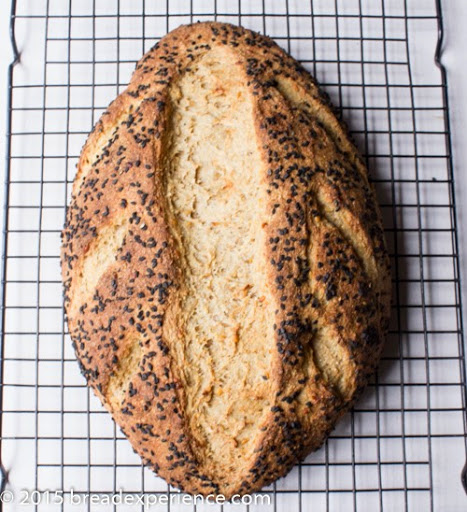
With this formula, you let the grains soak overnight in milk or buttermilk. I used kefir milk. It added a delightful flavor and soft texture to the bread.
This Struan also includes an overnight biga to provide extra lift for the grains. I sprinkled the top with black sesame seeds because I didn’t have any poppy seeds.
Multigrain Struan
Makes: 1 large loaf
Adapted from: Whole Grain Breads by Peter Reinhart
The volume of grains can vary based on the type of grain used and how coarsely the grains/flour are milled, so it is best to use a scale to measure the weight of the grains instead of measuring them by volume.
Soaker:
- 57 grams whole wheat flour (I used winter white whole wheat grains that I milled into flour)
- 170 grams mixture of grains, cooked or uncooked (I used a mixture of cornmeal, oats, spelt bran, 7-grain mix that I milled into flour, and flax seeds)
- 4 grams salt
- 170 grams milk, buttermilk, yogurt, or other milk (I used kefir milk)
Mix the soaker ingredients in a medium bowl until the grains and flour are completely hydrated and the dough becomes the consistency of porridge.
Cover the bowl loosely with plastic wrap and let it sit at room temperature for 12 to 24 hours. If it will be more than 24 hours before you plan to use the soaker, place it in the refrigerator. It will keep for up to 3 days.
Remove it about 2 hours before you plan to mix the final dough to take the chill off.
Biga:
- 227 grams white wholewheat flour
- 1 gram (1/4 tsp.) instant yeast
- 170 grams filtered or spring water, room temperature
In a medium bowl, mix the flour, yeast, and water until it forms a ball. Wet your hands and knead the dough ball for 2 minutes in the bowl to ensure the flour is completely hydrated and the ingredients are thoroughly incorporated. The dough will be very tacky. Let it rest for 5 minutes; then knead it again for another minute. It should feel smoother, but it will still be tacky.
Clean and dry the bowl and place the biga back in it. Cover the bowl tightly with plastic wrap and place it in the refrigerator overnight (8 hours) or up to 3 days.
Take the biga out of the refrigerator about 2 hours before you plan to mix the final dough to take off the chill. It should rise a bit, but not a lot.
Final Dough:
- All of the soaker
- All of the biga
- 57 grams white wholewheat flour
- 5 grams sea salt
- 1 1/2 teaspoons instant yeast
- 3 tablespoons honey
- 1 tablespoon unsalted butter, melted
1. The next day, remove the biga from the refrigerator and chop the soaker and biga into small pieces using a metal pastry scraper. Sprinkle some flour over the pieces to keep them from sticking together. Let them rest on the counter to take off the chill.
2. Place the soaker and biga pieces in a large bowl and add the rest of the ingredients on top. Stir the mixture vigorously with a wooden spoon or a Danish dough whisk. Using wet hands, knead the dough for about 2 minutes until all of the ingredients are evenly distributed into the dough. The dough will be soft and slightly sticky. If it’s too sticky, add a little flour.
3. Transfer the dough to a work surface dusted with flour. Knead the dough by hand for about 3 to 4 minutes until the dough feels soft and tacky, but not sticky. Add in additional flour a little at a time until it reaches the desired consistency, but be careful not to add too much. Shape the dough into a ball and let it rest for 5 minutes.
4. Knead the dough for 1 more minute to strengthen the gluten, then place it in a lightly oiled bowl. Turn to coat it in oil. Cover the bowl loosely with plastic wrap and let the dough rise for 45 to 60 minutes at room temperature. It should rise to 1 1/2 times its original size.
5. Place the dough on a lightly floured surface and shape it into a regular loaf shape or a freeform batard shape. I shaped mine into a batard. Cover the loaf loosely with plastic wrap and let it proof for 45 to 60 minutes, or until it is 1 1/2 times its original size.
For detailed instructions (including photos) on shaping a Batard, refer to the post on 66 Percent Sourdough Rye.
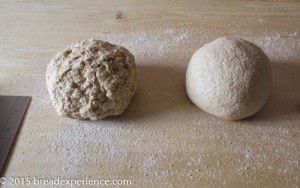 |
 |
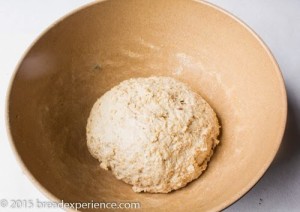 |
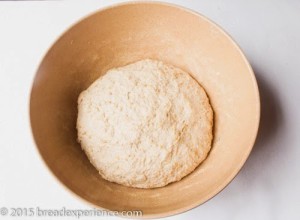 |
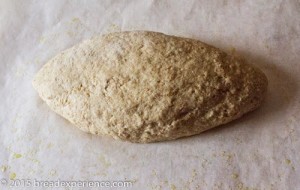 |
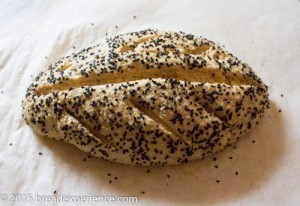 |
6. Preheat the oven to 450 degrees F. and prepare the oven for hearth baking by placing a baking stone on the bottom rack and a steam pan on the top rack. If you’re baking the loaf in a loaf pan, just preheat the oven to 425 degrees F.
7. When the dough has risen sufficiently, place the loaf on the preheated baking sheet and carefully place several ice cubes in the steam pan. Immediately close the door and turn the oven temperature down to 425 degrees F.
Bake the loaf for 20 minutes, then rotate it 180 degrees and continue to let it bake for another 20 minutes or so until the loaf is a rich brown color and it sounds hollow when thumped on the bottom. The loaf should register 195 degrees F. in the center with an instant-read thermometer.
8. Remove the loaf to a wire rack to cool for at least an hour before slicing and serving.
This a delicious multigrain loaf with lots of flavor and texture. It makes great toast!
Happy Baking!
Cathy
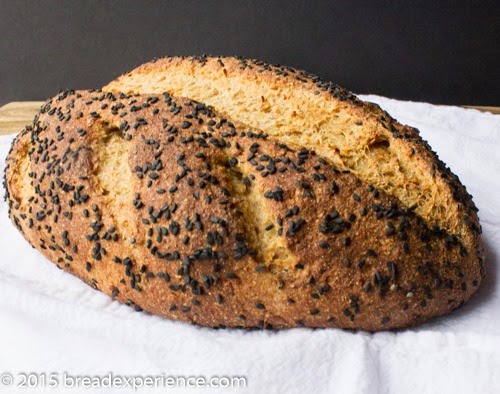
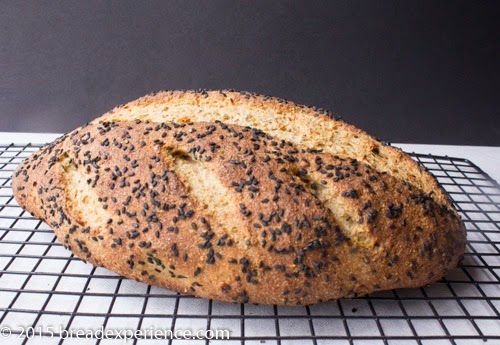
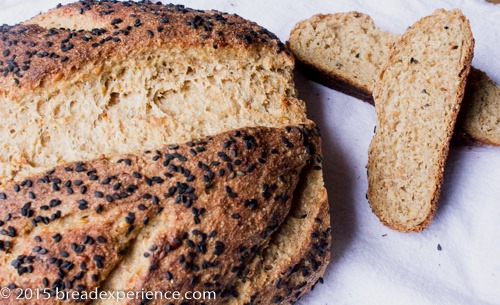
Judy says
I just made this recipe using cooked steel cut oatmeal. Even though I carefully weighed the ingredients, the soaker came out extremely wet and not like dough at all. When I combined the ingredients I had to add a lot more flour, about 2 cups, to turn the mixture into a still sticky dough. It rose nicely and behaved well after mixing and kneading, but became such a big heavy loaf that I had to make a batard rather than use a loaf pan. Miraculously, the loaf turned out quite well. Any ideas about what happened. I live in a humid climate but really!
Cathy says
Edited: If I’m understanding correctly, it sounds like you only used cooked steel cut oatmeal in the soaker and no other grains to soak up the milk. The original instructions do say that you can use cooked or uncooked grains; however, I think perhaps it’s assuming you will use a mixture of grains. If you are only using cooked oatmeal, I would add less cooked oatmeal and more whole wheat flour to the soaker.
Macha says
Hi, Kathy, did you mean to turn the oven down after putting the bread in the oven? Reinhart says to start at 450 as you do, but to turn it down to 350 when the bread goes in. Thanks!
Cathy says
Hi Macha,
I baked this loaf as a hearth loaf on a baking stone so I did not turn the oven down to 350. I turned it down to 425 degrees after preheating. If you are baking it in a loaf pan, then you probably do need to turn it down.
Here is a different version, which is baked in a loaf pan, at 375 degrees F. https://www.breadexperience.com/rustic-sourdough-cinnamon-raisin-struan/.
Happy Baking!
Cathy